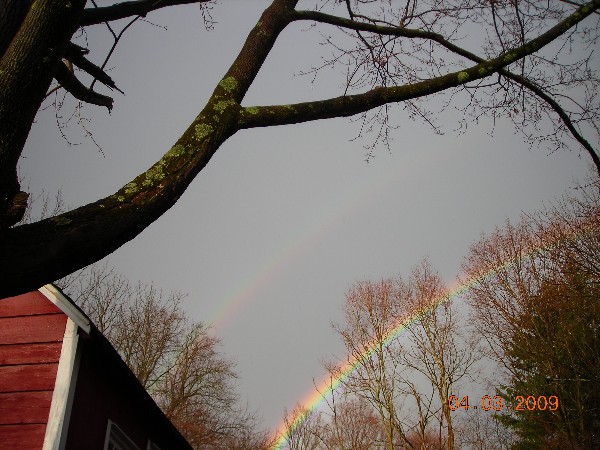
Friday, 3 April 2009
Rainbow in the Sky
I should never leave home without my camera. We were going across the road to have dinner with our neighbors. It had been raining off and on all day, with a drenching shower just before we set off. As we were starting up their long driveway I idly said to Paul, "I bet there's a rainbow." He thought it was too foggy. As we came around a small curve over to our right there was a fantastic rainbow. And a second one! Wow!
Sweetheart that he is, Paul said "Do you want me to go back to the house for your camera?" I said no, and then yes with barely time for a breath between. He let me out at the neighbors' door, turned the car around, and drove away. They were, naturally, somewhat confused until they heard me excitedly saying "Rainbow, rainbow, rainbow!" Both Bill and Georgia came out with their cameras, Paul came back with my camera, and with his, and the four of us were clicking away. Rainbows fade away so quickly . . . . .

Light rays undergoing a single reflection in raindrops either form the primary rainbow or brighten the sky inside it. A primary rainbow has its bands of color ranging from red on the outside to violet on the inside.
If there is a second rainbow it will appear to be fainter, dimmer, and wider. The colors of a secondary rainbow are in reverse order, with red inside and violet outside. That's because there is a double reflection of sunlight inside the raindrops.

Image courtesy of Georgia Muhs, 2009, all rights reserved
The sky under the primary rainbow appears to be lighter than the sky above. Sunlight that passes through the curved back side of raindrops also separates into different colors. The colors mix with light from other raindrops, and the mixed light again appears to be white. The additional rays contribute to the light sky under the rainbow, but that light is essentially achromatic since some rays of all colors emerge at those angles.
When there are two rainbows, the sky between the primary and secondary rainbows looks darker. Called Alexander's dark band, it is named for the Greek sage Alexander of Aphrodisias, who first described this phenomenon about 200 AD.
You want details? Light rays enter a raindrop from one direction, reflect off the back of the raindrop, and fan out as they leave the raindrop. The light is first refracted as it moves from the air and enters the surface of the raindrop. As it is reflected off by back of the water drop the light waves change direction, and refract again as they leave the raindrop. White light separates into different colors because red light (longer wavelength) is refracted by a lesser angle than blue light (shorter wavelength.) The air needs must be filled with water droplets, the colors we see arriving to our eyes from multitudinous different water droplets.

A prism shatters white light into its component colors. Raindrops falling from the sky.
If the sun is at a low angle, if you stand between sun and raindrops,
there can be magic in a transient arc of color washed across the sky.
Back to April 2009